check engine AUDI TT COUPE 2016 Workshop Manual
[x] Cancel search | Manufacturer: AUDI, Model Year: 2016, Model line: TT COUPE, Model: AUDI TT COUPE 2016Pages: 322, PDF Size: 52.86 MB
Page 244 of 322
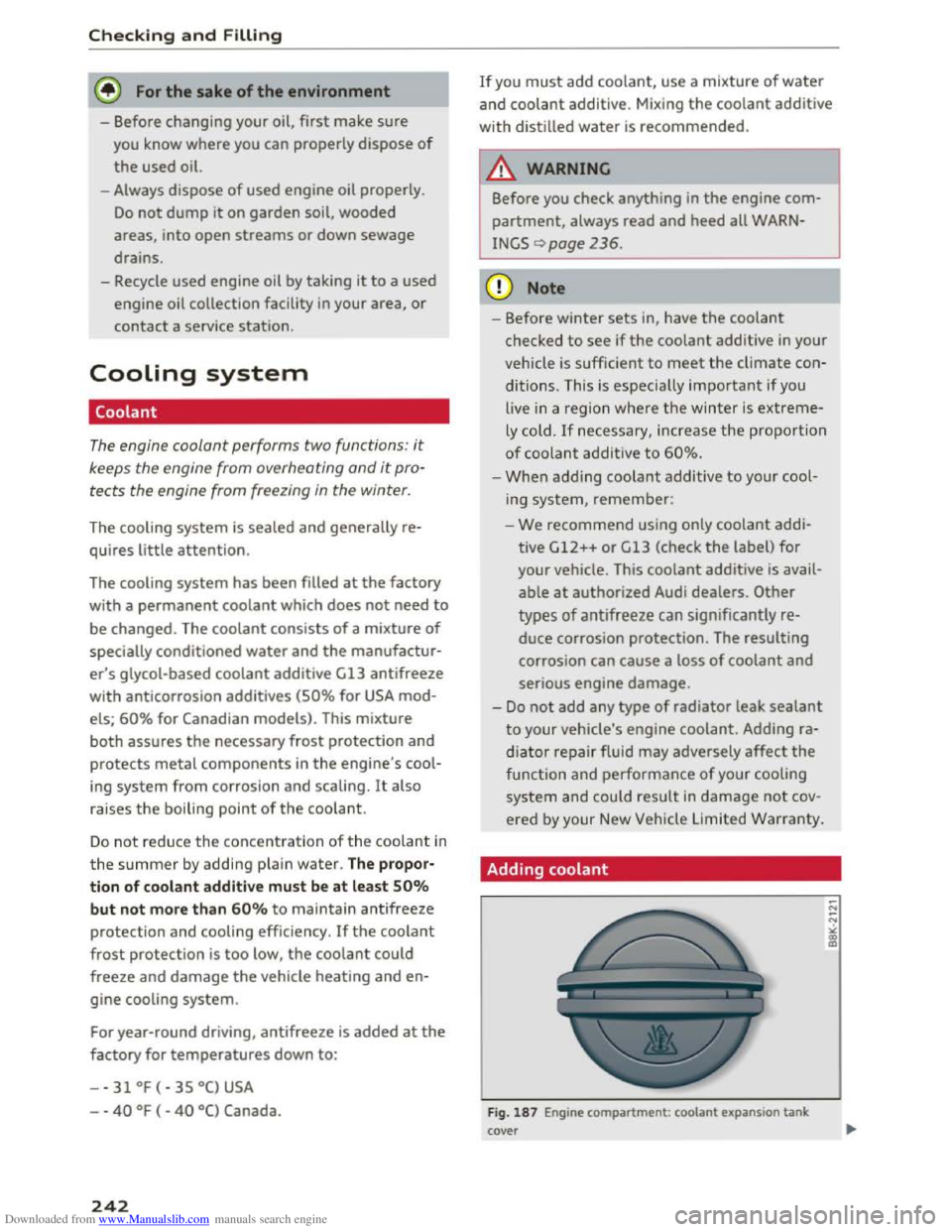
Downloaded from www.Manualslib.com manuals search engine Checking and Filling
@) For the sake of the environment
-Before changing your oil, first make sure
you know where you can properly dispose of
the used oil.
- Always
dispose of used engine oil properly.
Do not dump it on garden soil, wooded
areas, into open streams or down sewage
drains.
- Recycle
used engine oil by taking it to a used
engine oil collection facility in your area, or
contact a service station.
Coo Ling system
Coolant
The engine coolant performs two functions: it
keeps
the engine from overheating and it pro
tects the engine from freezing in the winter.
The cooling system is sealed and generally re
q uires
little attention.
The cooling
system has been filled at the factory
with a
permanent coolant which does not need to
be changed. The coolant consists of a mixture of
specially conditioned water and the manufactur
er's glycol-based coolant additive G13 antifreeze
with anticorrosion additives (50% for USA mod
els; 60% for Canadian models). This mixture
both assures the necessary frost protection and
protects metal components in the engine's cool
ing
system from corrosion and scaling. It also
raises
the boiling point of the coolant.
Do not reduce the concentrat ion of the coolant in
the summer by addi ng p la in water. The propor
tion of coolant additive must be at least 50°/o
but not more than 60°/o to maintain antifreeze
protection and cooling efficiency. If the coolant
frost protection is too low, the coolant could
freeze and damage the vehicle heating and en
gine cooling system.
For year-round driving,
antifreeze is added at the
factory for temperatures down to:
- -
31 °F ( -35 °C) USA
- -40 °F ( -40 °C) Canada.
242
If you must add coolant, use a mixture of water
and coolant additive. Mixing the coolant additive
with distilled
water is recommended.
A WARNING
~ h . Before you check anything in t e engine com-
partment, always read and heed all WARN
INGS C)page 236.
CD Note
-Before winter sets in, have the coo lant
checked to see if the coolant additive in you r
vehicle is
sufficient to meet the climate con
d itions. This is especia l
ly important if you
live
in a regio n where the winter is extre m e
ly cold . If necessary, increase the proportion
o f coo la
nt ad ditive to 60o/o.
-When add ing coolant additive to your cool
ing
system, remember:
-We recommend using only coolant addi
tive G12++
or G13 (check the label) for
your vehicle. This coolant additive is avail
able at authorized Audi dealers. Other
types of antifreeze can significantly re
duce corrosion protection. The resulting
corrosion can cause a loss of coolant and
serious engine damage.
-Do not add any type of radiator leak sealant
to your vehicle's engine coolant. Adding ra
dia to r repair fluid may adversely
affect the
func tion and performance of your cooling
system and could result in damage not cov
ered by your New Veh icle Limited W arranty .
Adding coolant
Fig. 187 Engine compartment : coolant expansion tank
cover
Page 245 of 322
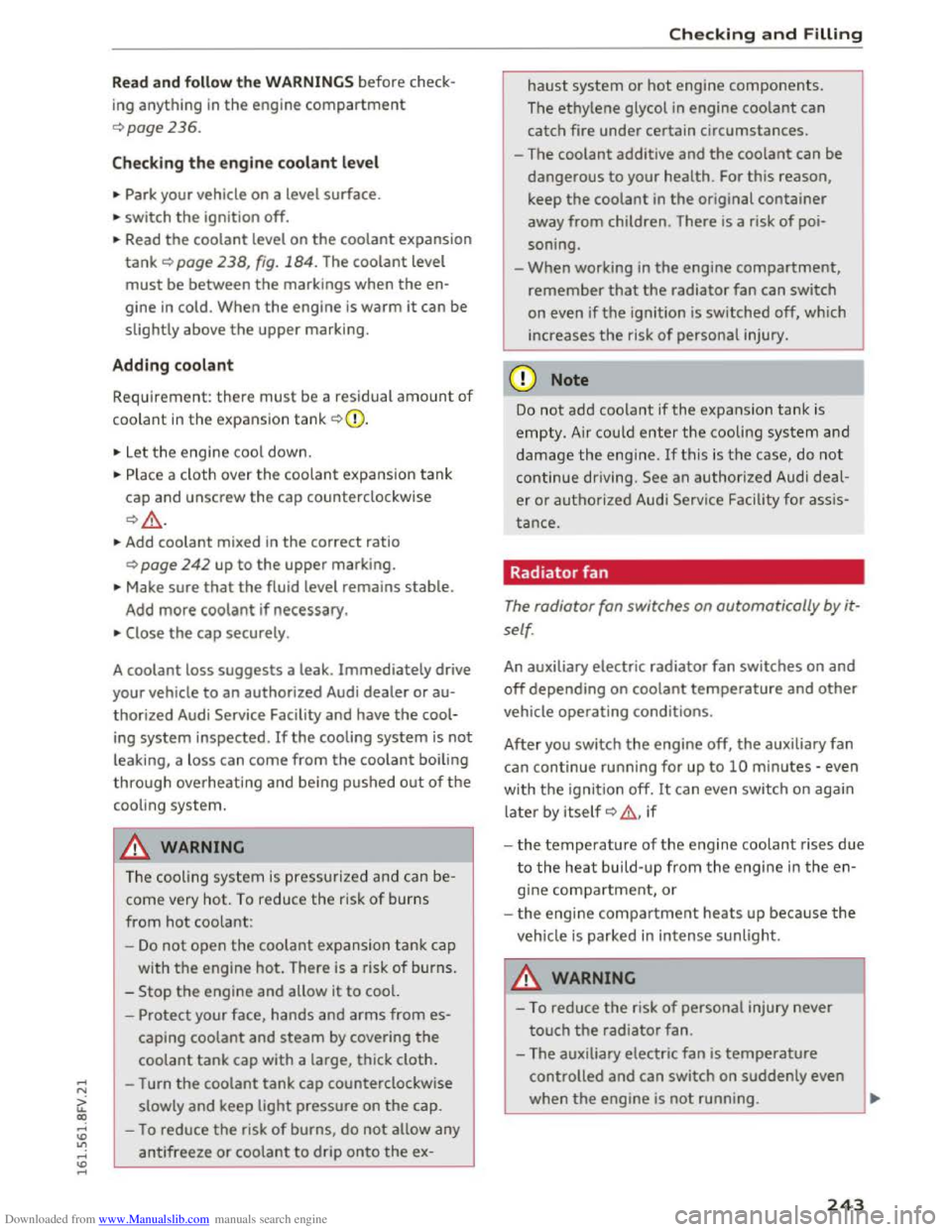
Downloaded from www.Manualslib.com manuals search engine ...... N
> u. CX> ...... u:>
"' ...... u:> ......
Read and follow the WARNINGS before check
ing anything
in the engine compartment
Qpage236.
Checking the engine coolant level
""Park your vehicle on a level surface.
"" switch the ignition off.
.. Read the coolant level on the coolant expansion
tank
Q page 238, fig. 184. The coolant level
must be between the markings when the en
gine
in cold. When the engine is warm it can be
slightly above
the upper marking.
Adding coolant
Requirement: there must be a res idual amount of
coo l
ant in the expans io n tank c:?(i) .
""Let the engine cool down.
.. Place a cloth over the coolant expansion tank
cap and unscrew
the cap counterclockwise
c:?,8..
""Add coolant mixed in the correct ratio
i:?page 242 up to the upper marking.
""Make sure that the fluid level remains stable.
Add more coolant if necessary.
"" Close the cap securely .
A coolant loss suggests a leak. Immediately drive
your vehicle
to an authorized Audi dealer or au
thorized
Audi Service Facility and have the cool
ing system inspected.
If the cooling system is not
leaking, a loss can come from
the coolant boiling
through overheating and being pushed
out of the
cooling system.
.&. WARNING
-The cooling system is pressurized and can be-
come very hot.
To reduce the risk of burns
from hot coolant:
-
Do not open the coolant expansion tank cap
w ith
the engine hot. There is a risk of burns .
- Stop
the engine and allow it to cool.
-
Protect your face, hands and arms from es-
caping coolant and
steam by covering the
coolant tank cap with a large, thick cloth.
- Turn
the coolant tank cap counterclockwise
slowly and keep light pressure on
the cap.
-
To reduce the risk of burns, do not allow any
antifreeze or coolant to dr
ip onto the ex-
Checking and Filling
ha ust system or hot engine components.
The ethylene glycol in engine coolant can
catch fire under certain circumstances.
- The coolant additive and the coolant can be
dangerous to your health.
For this reason,
keep
the coolant in the original container
away from children. There is a
risk of poi
soning.
-When working in the engine compartment,
remember
that the radiator fan can switch
on even if
the ignition is switched off, which
increases
the risk of personal injury.
CD Note
Do not add coolant if the expans ion tank is
empty . Air could enter the cooling system and
damage
the eng ine. If this is the case, do not
continu e driving. See an authorized
Audi dea l
er or authorized
Audi Service Facility for assis
tance.
Radiator fan
The radiator fan switches on automatically by it
self.
An auxiliary electric radiator fan switches on and
off depending on coolant temperature and other
vehicle operating conditions.
After you switch
the engine off, the auxiliary fan
can continue running for
up to 10 minutes -even
with
the ignit ion off. It can even switch on again
later by itself c:? & . if
- the temperature of
the engine coolant rises due
to
the heat build-up from the engine in the en
gine compartment, or
-
the engi ne compartment heats up because the
vehicle is parked in intense sunlight.
.&. WARNING
-To reduce the risk of personal injury never
touch
the radiator fan.
- The auxiliary electric fan
is temperature
controlled and can switch on suddenly even
when
the engine is not running.
243
Page 246 of 322
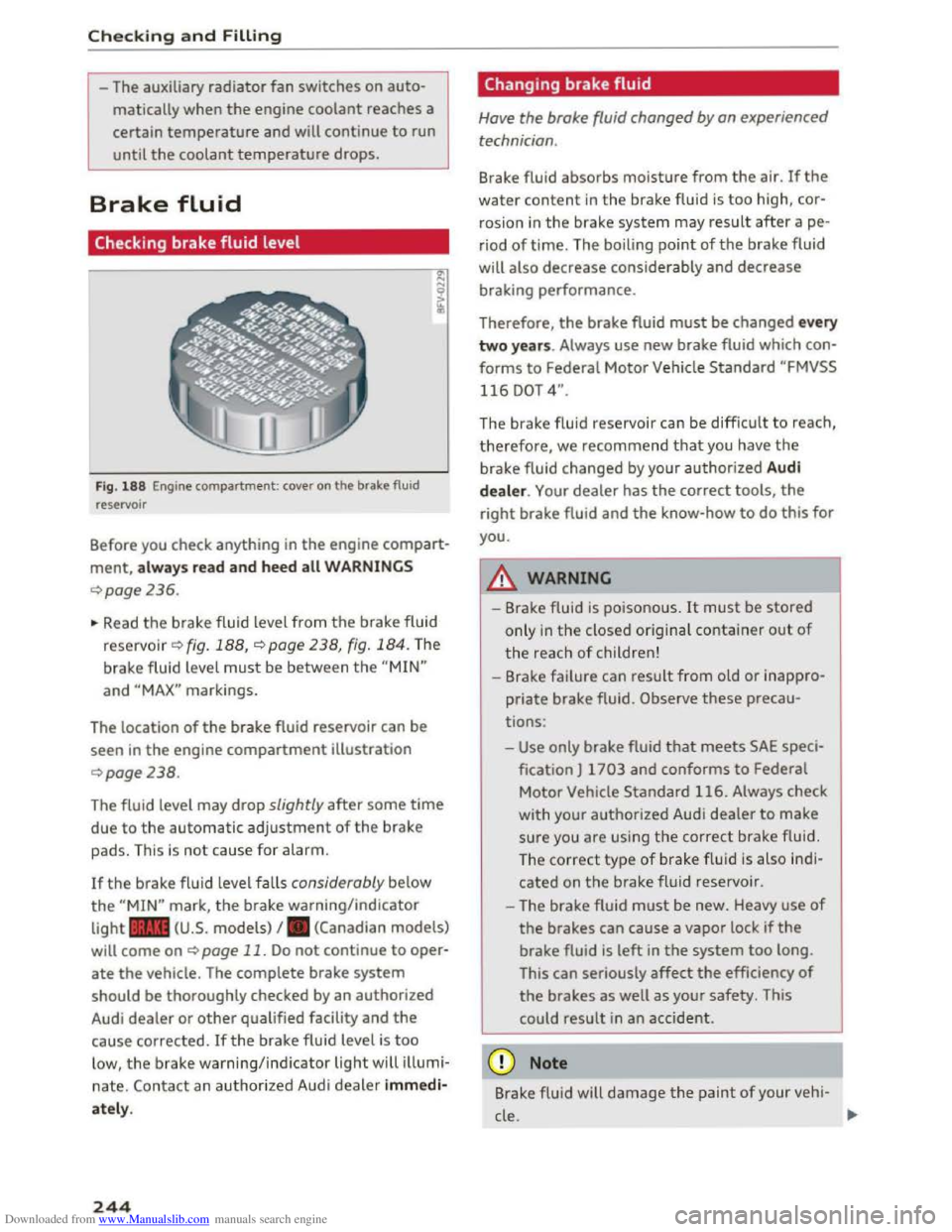
Downloaded from www.Manualslib.com manuals search engine Checking and Filling
-The auxiliary radiator fan switches on auto
matically when the engine coolant reaches a
certain temperature and will continue to run
until the coolant temperature drops.
Brake fluid
Checking brake fluid level
Fig. 188 Engine compartment: cover on the brake fluid
reservoir
Before you check anything in the engine compart
ment, always read and heed all WARNINGS
¢page 236.
~ Read the brake fluid level from the brake fluid
reservo ir ¢ fig. 188, ¢page 238, fig. 184. The
brake fluid level must be between the "MIN"
and "MAX" markings.
The location
of the brake fluid reservoir can be
seen in the engine compartment illustration
¢page238.
The fluid level may drop slightly after some time
due to the automatic adjustment of the brake
pads. This is not cause for alarm.
If the brake fluid level falls considerably below
the "MIN" mark, the brake warning/indicator
light .. (U.S. models) I. (Canadian models)
will come on ¢ page 11. Do not continue to oper
ate the vehicle. The complete brake system
should be thoroughly checked by an authorized
Audi dealer or other qualified facility and the
cause corrected. Ifthe brake fluid level is too
low, the brake warning/indicator light will illumi
nate. Contact an authorized Audi dealer immedi
ately.
244
Changing brake fluid
Have the brake fluid changed by an experienced
technician .
Brake fluid absorbs moisture from the air. If the
water content in the brake fluid is too high, cor
rosion in
the brake system may result after ape
riod of time. The boiling point of the brake fluid
will
also decrease considerably and decrease
braking performance.
Therefore, the brake fluid must be changed every
two years. Always use new brake fluid which con
forms to Federal Motor Vehicle Standard "FMVSS
116 DOT 4".
The brake fluid reservoir can be difficult to reach,
therefore, we recommend that you have the
brake fluid changed by your authorized Audi
dealer. Your dealer has the correct tools, the
right brake fluid and the know-how to do this for
you.
8._ WARNING
- Brake fluid is poisonous. It must be stored
only in the closed original container out of
the reach of children!
-Brake failure can result from old or inappro
priate brake fluid. Observe these precau
tions:
-Use only brake fluid that meets SAE speci
fication
J 1703 and conforms to Federal
Motor Vehicle Standard 116. Always check
with
your authorized Audi dealer to make
sure you are using the correct brake fluid.
The
correct type of brake f lui d is also ind i
cated on the brake fluid reservoir .
- The
brake fluid must be new. Heavy use of
the brakes can cause a vapor lock if the
brake fluid is left in the system too long.
This
can seriously affect the efficiency of
the brakes as well as your safety. This
could
result in an accident.
CD Note
Brake flu id will damage the paint of your veh i-
cle .
JIJ.
Page 247 of 322

Downloaded from www.Manualslib.com manuals search engine ~ For the sake of the environment
Because of the problem of proper disposal of
brake fluid as well as the special tools re
quired
and the ne cessary expertise, we rec
ommend that you have the brake fluid
changed by your authorized Audi dealer.
Battery
General information
The battery in your Audi does not need any main
tenance under normal operating conditions. Audi
recommends having the electrolyte level check
by an
authorized Audi dealer or authorized Audi
Service Facility
when there are high outside tem
peratures or when driving all day. The electrolyte
level should also be checked each time the bat
tery is charged ~page 247.
Have the battery checked when you bring your ve
hicle
in for an inspection . It is a good idea to re
place
the battery if it is more than S years old.
Sometimes when the airbags deploy, the battery
will be disconnected from the vehicle electrical
system for safety reasons ~.&in Repair, care
and disposal
of the airbags on page 203.
Disconnecting the battery
The battery should not be disconnected. Several
vehicle functions (power windows, for
example)
will be lost when the battery is disconnected. The
functions must be reprogrammed after connect
ing the battery. To avo id this, the battery should
only be disconnected from the vehicle electrica l
system when it is absolutely necessary.
Not running the vehicle for long periods of
time
If you do not drive your vehicle for several days or
weeks, electrical consumers are gradually scaled
back
or switched off. This reduces energy use and
ensures the vehicle will be able to start after long
periods of time~ page 92. Some convenience
functions, su ch
as interior lighting or power seat
adjustment, may not be available under certain
circumstances. These convenience functions will
be available again once you switch
the ignition on
and start the engine.
Checking and Filling
Winter operation
A lot of stress is placed on the battery during
cold weather, which results in reduced starting
ability. Have the battery checked and recharged if
necessary
before the cold weather begins.
A WARNING
- Work on the battery requires expert know l
edge. Contact an authorized Audi dealer or
authorized Audi Service Facility for informa
tion regarding the vehicle battery. There is a
risk for chemical
burns or explosions.
- Never
open the vehicle battery. Do not try to
change the battery electrolyte level. Other
wise explosive
gas will escape from the bat
tery and increase the risk of an exp losion. ___ ....J
Working on the battery
Be especially careful when working on or near
the battery.
The battery is located in the luggage compart
ment under the floor . Before you check anything
in the luggage compartment, read and heed all
WARNINGS~_&.
Always heed the safety warnings , when working
on
the vehicle battery or the vehicle electrical
system to prevent injury.
The following WARNINGS are very important
when working on the battery:
Always heed the following WARNING SYM-
BOLS and safety precautions when working on
the battery.
®
Always wear eye protection.
&
Battery acid contain s sulfuric acid. Al-
ways wear gloves and
eye protection .
@
No
- sparks
- flames
- smoking.
245
Page 248 of 322
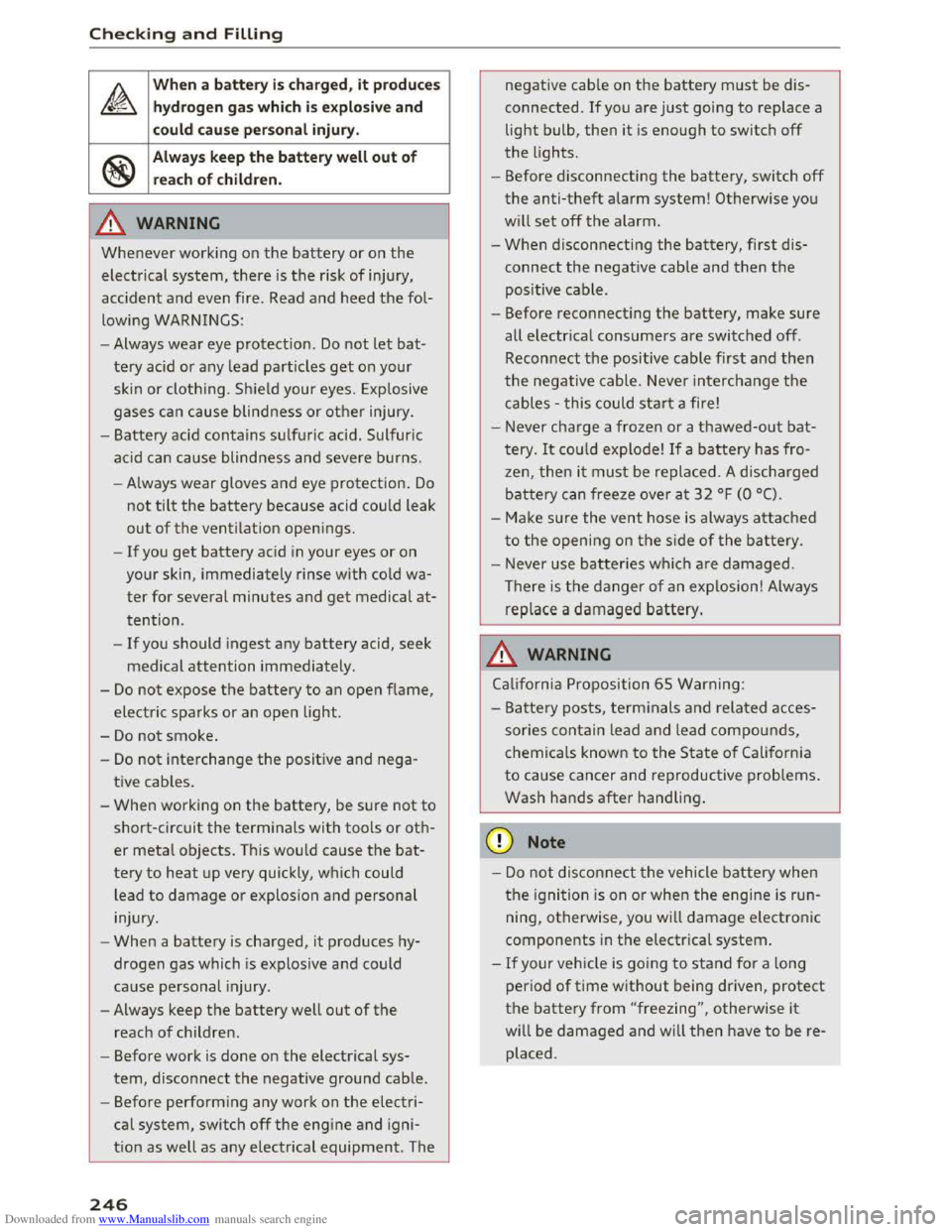
Downloaded from www.Manualslib.com manuals search engine Checking and F illing
~
When a b attery is char ged, it pro duces
hyd rogen gas whi ch i s e xplo sive and
could
cau se pers onal injury.
®
Always kee p the battery well out of
re ach of childre n.
A WARNING
Whenever working on the ba ttery or on the
electrical system, there is the risk of injury,
accident and even fire. Read and heed the fol
lowing
WARNINGS:
- Always wear eye protection. Do not let bat
tery acid or any lead particles get on your
skin or clothing . Shield your eyes. Explosive
gases can cause blindness or other injury.
-
Battery acid contains sul furic acid. Sulfuric
acid
can cause blindness and severe burns.
- Always
wear gloves and eye protection. Do
not tilt the battery because acid could leak
out of the ventilation openi ngs.
- If you
get battery acid in your eyes or on
your skin, immediately rinse with cold wa
ter for several minutes and get medical at
tention.
-
If you should ingest any battery acid, seek
medical attention immediately.
-
Do not expose the battery to an open flame,
electric sparks or an open light.
-
Do not smoke.
-Do not interchange the positive and nega-
tive
cables.
-When working on the battery, be sure not to
short-circuit the terminals with tools or oth
er metal objects. This would cause the bat
tery to heat up very quickly, which could
lead to damage or explosion and personal
injury.
-
When a battery is charged, it produces hy
drogen gas which is explosive and could
cause personal injury .
- Always keep
the battery well out of the
reach of children.
- Before work is
done on the electrical sys
tem, disconnect the negative ground cable.
- Before
performing any work on the electri
cal
system, switch off the engi ne and igni
t i
on as well as any electrical equipment. The
246
-
negative cabl e on the battery m ust be dis
connected. If you are just going to replace a
light bulb,
then it is enough to switch off
the lights.
- Before di
sconnecting the battery, switch off
the anti-theft alarm system! Otherwise you
w ill
set off the alarm.
-
When disconnecting the battery, first dis
connect the negative cabl e and then the
positive cable.
- Before
reconnecting the battery, make sure
all electrical consumers are switched off.
Reconnect
the positive cable first and then
the negative cable. Never interchange the
cables -this could start a fire!
- Never
charge a frozen or a thawed-out bat
tery. It cou ld explode! If a battery has fro
zen,
then i t must be replaced. A discharged
b attery can freeze ove r at 32 °F (O °C).
-Make sure the vent hose is always attached
to the opening on the side of the battery .
- Never
use batteries which are damaged.
There is th e danger of an exp losion! Always
replace a da maged battery .
A WARNING
Cali fornia Proposition 65 Warning:
-
Batter y posts, ter m inals and related acces
sories contain lead a nd lead compounds,
chemicals known to the State of California
to cause cancer and reproductive problems.
Wash
hands after handling .
CD Note
-Do not disconnect the vehicle battery when
the ignition is on or when the engine is run
ning,
otherwise, you will damage electronic
components in the e lectrical system.
-If your veh icle is going to stand for a long
period of time without being driven, protect
the battery from "freezing" , otherwise it
will be damaged and will then have to be re
placed .
Page 249 of 322
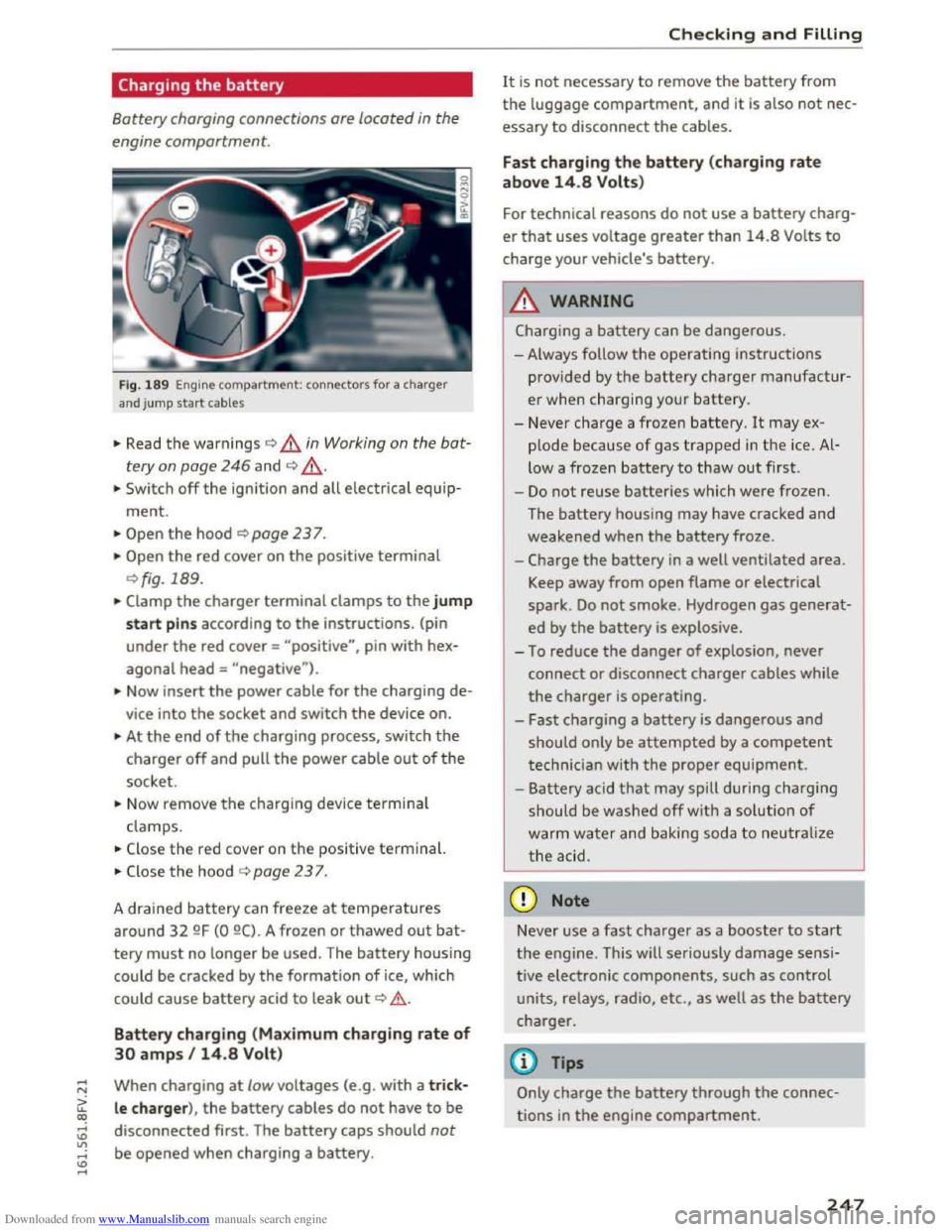
Downloaded from www.Manualslib.com manuals search engine Charging the battery
Battery charging connections are located in the
engine comportment.
Fig . 189 Engine compartment: connectors for a charger
and jump start cables
• Read the warnings ~,&.in Working on the bat
tery on page 246 and ~ ,&..
•Switch off the ignition and all electrical equip
ment.
• Open the hood ~page 23 7.
• Open the red cover on the positive terminal
~fig. 189.
•Clamp the charger terminal clamps to the jump
start pins according to the instructions. (pin
under the red cover= "positive", pin with hex
agonal head= "negative").
•
Now insert the power cable for the charging de
vice into the socket and switch the device on.
•At the end of the charging process, switch the
charger off and pull the power cable out of the
socket.
•Now remove the charging device terminal
clamps.
• Close the red cover on the positive terminal.
•Close the hood ~page 23 7.
A drained
battery can freeze at temperatures
around 32 QF (0 QC). A frozen or thawed out bat
tery must no longer be used. The battery housing
could be cracked by
the formation of ice, which
could cause
battery acid to leak out¢& .
Battery charging (Maximum charging rate of
30 amps I 14.8 Volt)
When charging at low voltages (e.g. with a trick
le charger ), the battery cables do not have to be
disconnected first. The battery caps should not
be opened when charging a battery.
Checking and Filling
It is not necessary to remove the battery from
the luggage compartment, and it is also not nec
essary to disconnect the cables.
Fast charg ing the battery ( charging rate
above
14. 8 Volts)
For technical reasons do not use a battery charg
er that uses voltage greater than 14.8 Volts to
charge your vehicle's battery.
A WARNING
!-='"
Charging a battery can be dangerous.
-Always follow the operating instructions
provided by
the battery charger manufactur
er when charging your battery.
-Never charge a froze n battery. It may ex
plode because of gas trapped in the ice. Al
low a frozen battery to thaw out first.
-
Do not reuse batteries which were frozen.
The
battery housing may have cracked and
weakened
when the battery froze.
-
Charge the battery in a well ventilated area.
Keep away
from open flame or electrical
spark.
Do not smoke. Hydrogen gas generat
ed by the battery is explosive.
-
To reduce the danger of explosion, never
connect or disconnect charger cables while
the charger is operating.
-Fast charging a battery is dangerous and
should only be attempted by a competent
technician with the proper equipment.
-Batte ry ac id that may spill during charging
should be washed
off with a so lution of
warm water and baking soda to neutralize
t
he acid.
CD Note
Never use a fast charger as a booster to start
the engine. This will seriously damage sensi
tive electronic components, such as control
units, relays, radio,
etc., as well as the battery
charger.
Tips
Only charge the battery through the connec
tions in the engine compartment.
247
Page 250 of 322

Downloaded from www.Manualslib.com manuals search engine Checking and Filling
Battery replacement
The new battery must have the same specifica
tions and dimensions as the original equipment
battery .
Intelligent energy management in your vehicle is
responsible for distributing the electrical energy
throughout your vehicle Q page 92. The intelli
gent energy management system will keep the
engine battery charged better than vehicles with
out this system. To make sure the additional
electrical energy is available once again after you
have
changed the battery, we recommend that
you install batteries of the same type and manu
facture only (the same as those insta lled at the
time your vehicle was delivered). Specificat ions
are listed on the battery housing. Your author
ized dealer must code the battery in the energy
management system to enable you to use the en
ergy management functions correctly after re
placing the battery.
The new
battery must have the same capacity,
voltage (12-volts) , amperage, construction and
plug sealing.
When installing the battery, make sure the igni
tion and all electrical consumers are switched
off.
CD Note
Make
sure the ventilation hose on the side of
the battery is connected, otherwise fumes or
battery acid can leak out.
@ For the sake of the environment
Because
of the problem of proper disposal of
a battery, we recommend your authorized
Audi dealer change the battery for you. Bat
teries contain sulfuric acid and lead and must
always be disposed of properly in compliance
with all
environmental regulations. Disposing
of vehicle batteries improperly is very danger
ous to the environment.
248
Windshield washer
system
Fig. 190 Eng ine compartment: washer flu id reservo ir cap
The windshield washer reservoir W contains the
cleaning solution for the windsh ield and the
headlight washer system* Q page 238, fig. 184.
The reservoir capacity is found in Q page 299.
To reduce the risk of lime scale deposits on the
spray nozzles, use clean water with low amounts
of calcium. Always add window cleaner to the wa
ter. When the outside temperatures are cold, an
anti-freezing
agent should be added to the water
so that it does not freeze .
CD Note
- The
concentration of anti-freezing agent
must be adjusted to the vehicle operating
conditions in the respective climate. A con
centration that is too high can lead to vehi
cle damage.
-Never add radiator anti-freeze or other addi
tives to the washer fluid.
-
Do not use a glass cleaner that contains
paint solvents, because this can damage the
paint.
Page 251 of 322
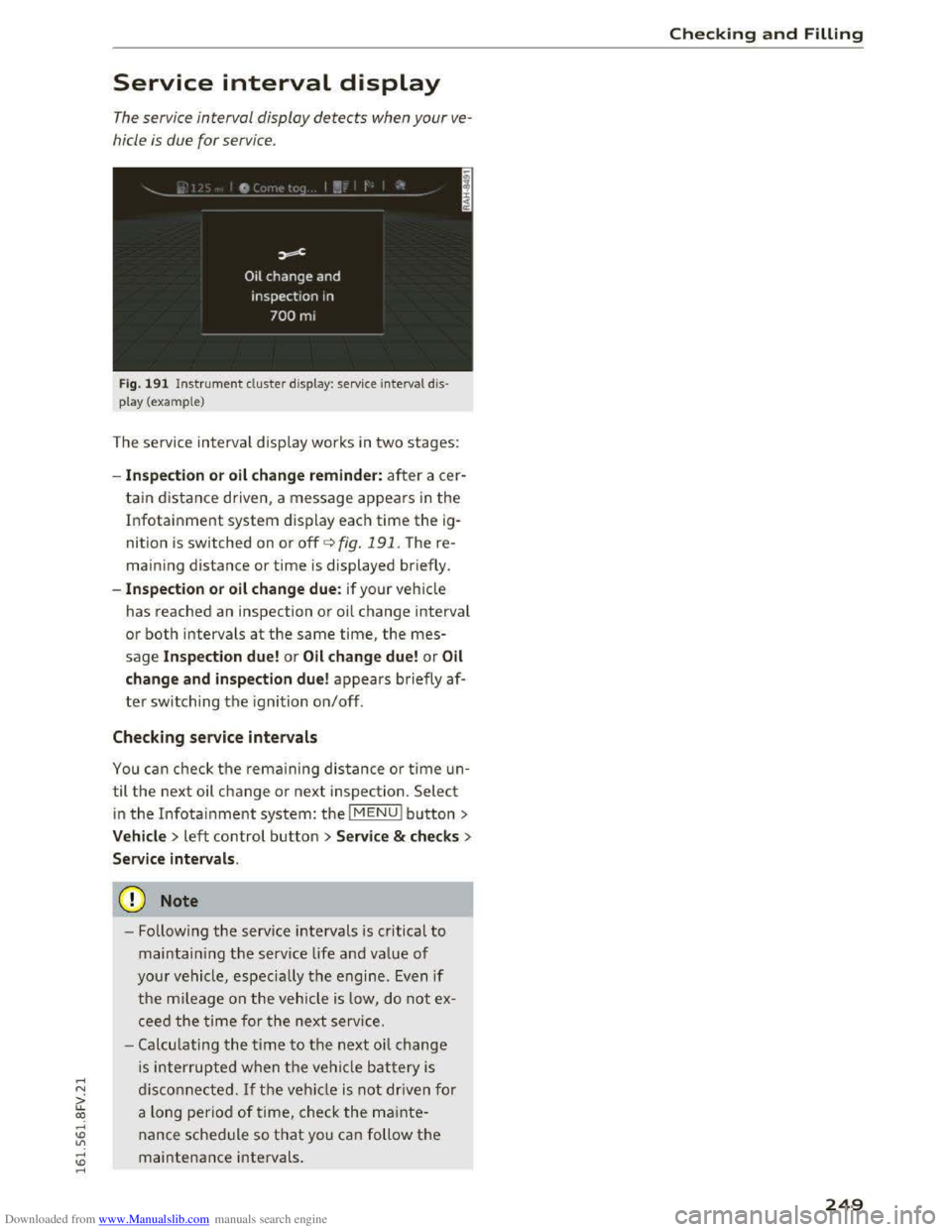
Downloaded from www.Manualslib.com manuals search engine ..... N
G: CX)
.....
"' U"I
.....
"' .....
Service interval display
The service interval display detects when your ve
hicle
is due for service.
Fig . 191 Inst rument cluster display: serv ice in terva l d is
p lay (exa mpl
e)
The service interval display works in two stages:
-Inspection or oil change reminder: after a cer
tain distance driven, a message appears in the
Infotainment system display each time the ig
nition is switched on
or off¢ fig. 191. The re
main ing
distance or time is displayed briefly.
-Inspection or oil change due: if your vehicle
has reached an inspection or oil change interval
or both intervals at the same time, the mes
sage Inspection due! or Oil chang e due! or Oil
cha nge and inspection due! appears briefly af
ter switching the ignition on/off.
Check ing s ervice intervals
You can check the remaining distance or time un
til the next oil change or next inspection. Select
in the Infotainment system: the IMENUI button>
Vehicle > left control button > Ser vice & checks >
Service intervals .
@ Note
-Follow ing the service intervals is critical to
maintaining the service life and value of
your vehicle, especially the engine. Even if
the mileage on the vehicle is low, do not ex
ceed
the time for the next service.
- Calcu l
ating the time to the next o il change
is interrupted when the vehi cle battery is
disco n
nected. If the vehicle is not driven for
a long period
of time, check the mainte
nance schedule so that you can follow th e
maintenance intervals .
Checking and Filling
249
Page 252 of 322
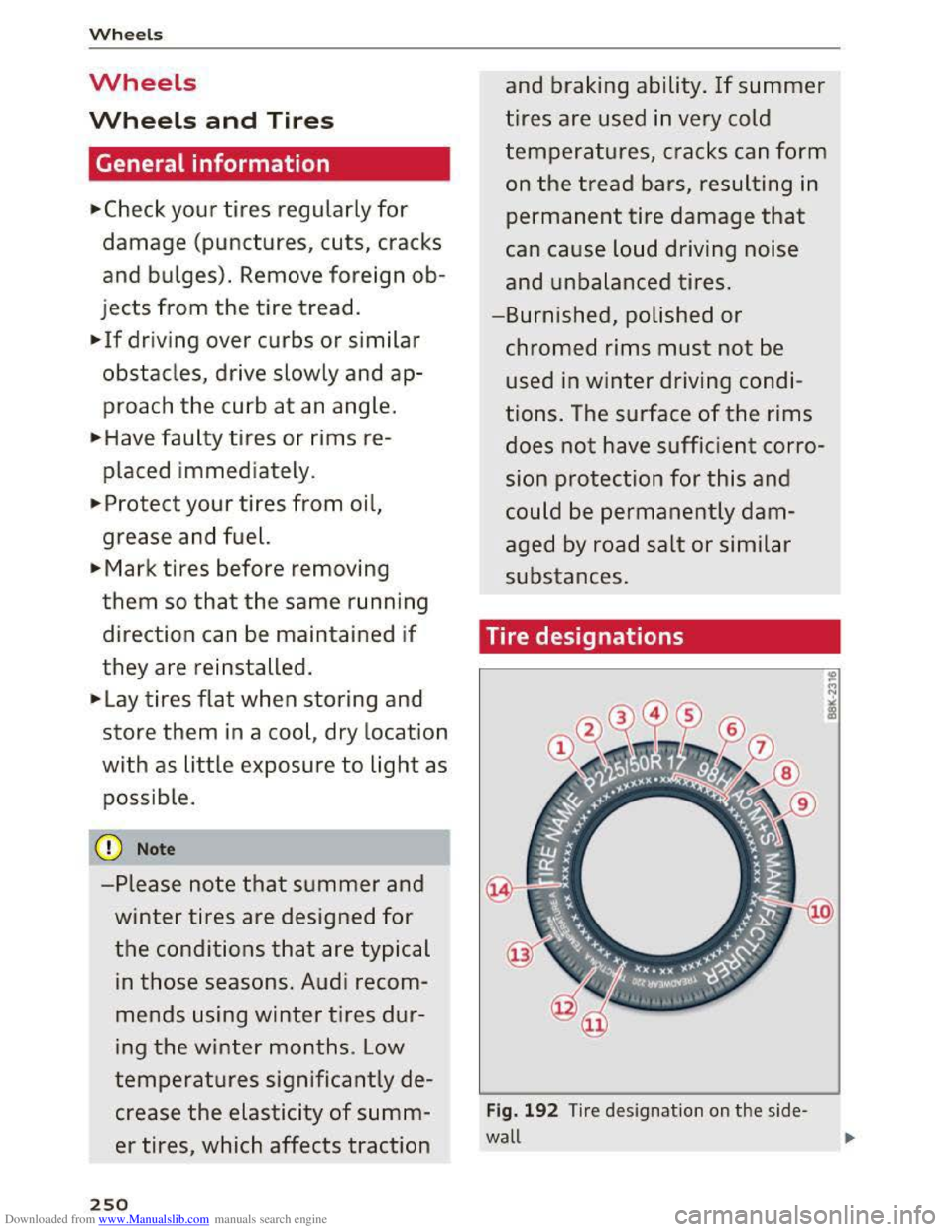
Downloaded from www.Manualslib.com manuals search engine Wheels
Wheels
Wheels and Tires
General information
.,.Check your tires regularly for
damage (punctures, cuts, cracks
and bulges). Remove foreign ob
jects from the tire tread.
.,. If driving over curbs or similar
obstacles, drive slowly and ap
proach the curb at an angle.
.,.Have faulty tires or rims re
placed
immediately.
.,.Protect your tires from oil,
grease and fuel.
.,.Mark tires before removing
them so that the same running
direction can
be maintained if
they are reinstalled .
... Lay tires flat when storing and
store them in a cool, dry location
with
as little exposure to light as
possible.
CD Note
-Please note that summer and
winter tires are designed for
the conditions that are typical
in those seasons. Audi recom
mends using winter tires dur
ing the winter months. Low
temperatures significantly de
crease the elasticity of summ
er tires, which affects traction
250
and braking ability. If summer
tires are used in very cold
temperatures, cracks can form
on the tread bars, resulting in
permanent tire damage that
can cause loud driving noise
and unbalanced tires.
-Burnished, polished or
chromed rims must not be
used in winter driving condi
tions. The surface of the rims
does not have sufficient corro
sion
protection for this and
could be permanently dam
aged by road salt or similar
substances.
Tire designations
Fig. 192 Tire designation on the side
wall
Page 260 of 322
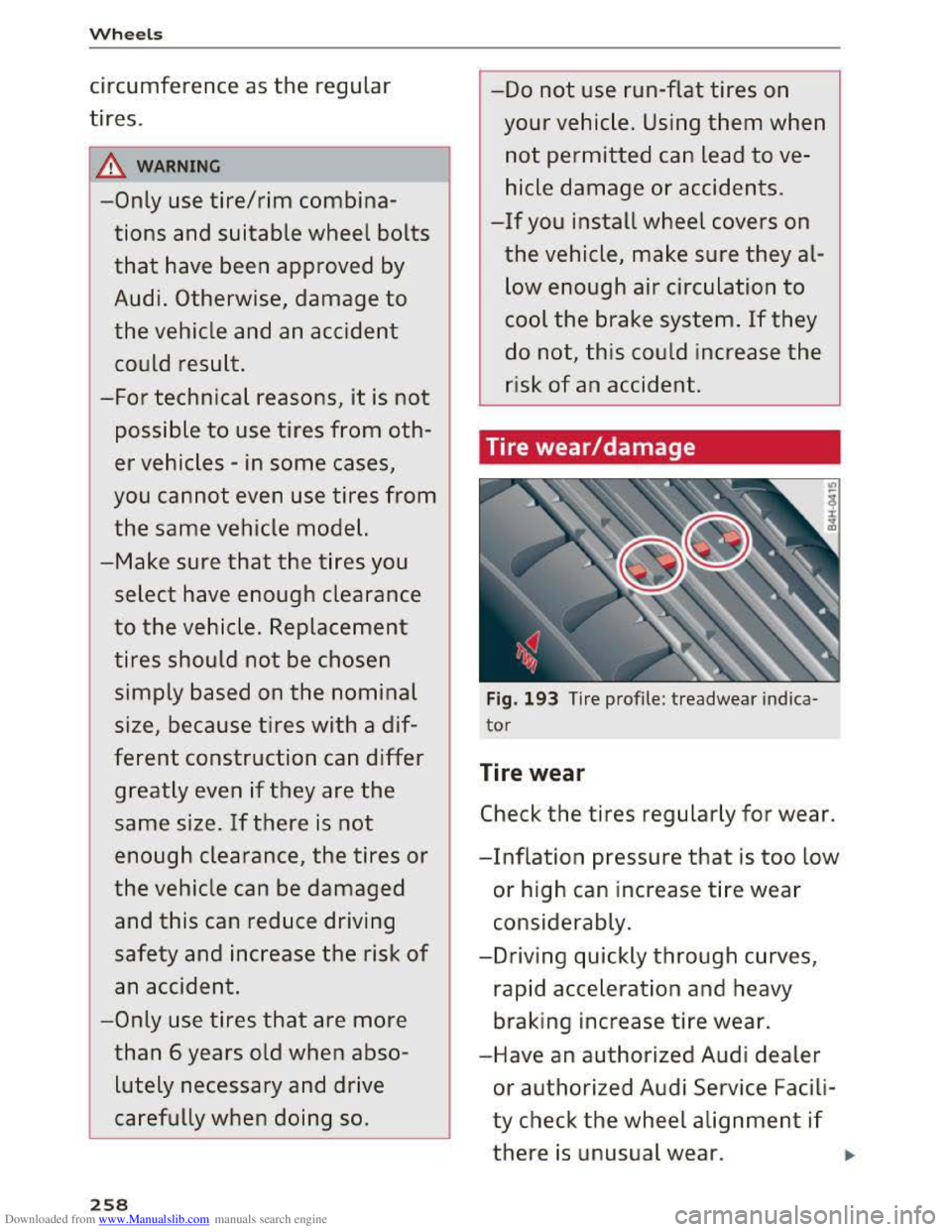
Downloaded from www.Manualslib.com manuals search engine Wheels
circumference as the regular
tires.
II WARNING -I
-Only use tire/rim combina
tions and suitable wheel bolts
that have been approved by
Audi. Otherwise,
damage to
the vehicle and an accident
could result.
-For technical reasons, it is not
possible to use tires from oth
er vehicles -in some cases,
you cannot even use tires from
the same vehicle model.
-Make sure that the tires you
select have enough clearance
to the vehicle. Replacement
tires should not be chosen
simply based on the nominal
size, because tires with a dif
ferent construction can differ
greatly even if they are the
same size. If there is not
enough clearance, the tires or
the vehicle can be damaged
and this can reduce driving
safety and increase the risk of
an accident.
-Only use tires that are more
than 6 years old when abso
lutely necessary and drive
carefully
when doing so.
258
-Do not use run-flat tires on
your vehicle. Using them when
not permitted can lead to ve
hicle
damage or accidents.
-If you install wheel covers on
the vehicle, make sure they al
low
enough air circulation to
cool the brake system. If they
do not, this could increase the
risk of an accident.
Tire wear/damage
Fig. 193 Tire profile : treadwear indica
tor
Tire wear
Check the tires regularly for wear.
-Inflation pressure that is too low
or high can increase tire wear
considerably.
-Driving quickly
through curves,
rapid
acceleration and heavy
braking
increase tire wear.
-Have an authorized Audi dealer
or authorized Audi Service Facili
ty check the wheel alignment if
there is unusual wear.